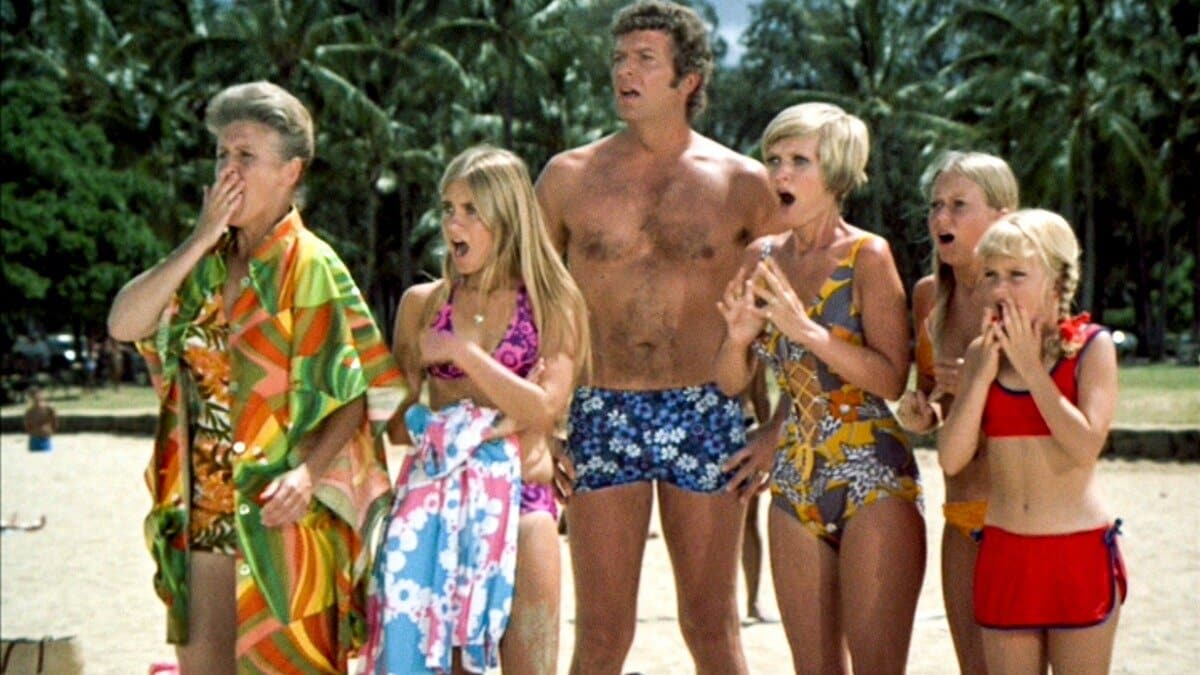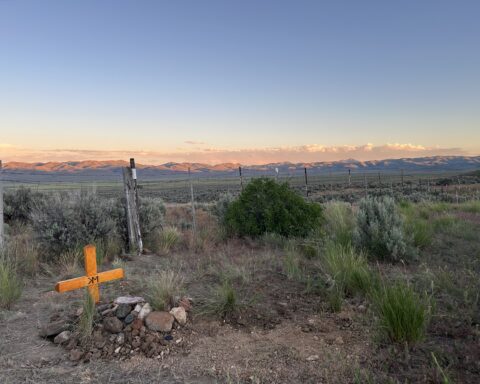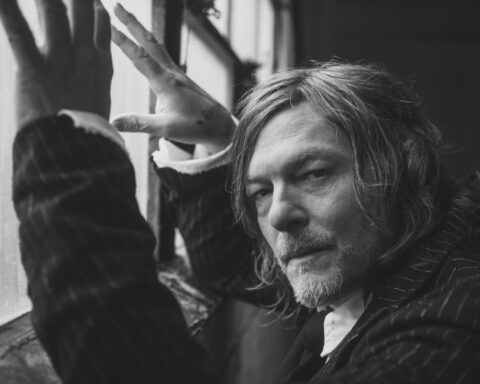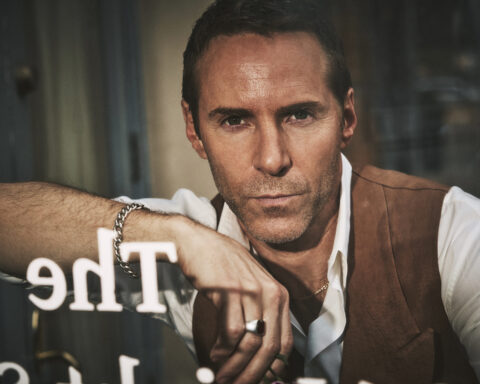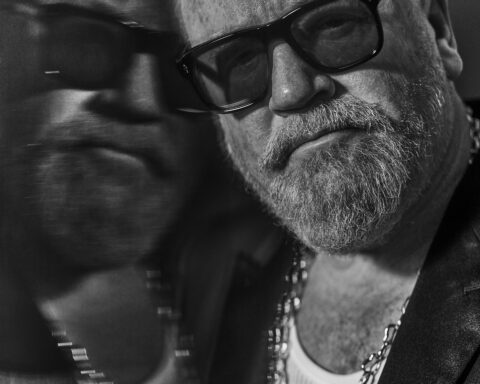“As to the worst show offered, there’s no competition. It’s ‘Brady Bunch.’ It is so cloyingly, nauseatingly sweet, so insufferably cute, so embarrassingly bad that discussing it becomes an ordeal.” -Cecil Smith, Los Angeles Times, October 1969
“You have to enter a specific kind of mental space when you watch the show.” -Christopher Knight aka Peter Brady, DVD Commentary, 2005
I started watching ‘The Brady Bunch’ in fourth grade, which made the year of my entry around 1982, which meant ‘The Brady Bunch’ was well into its success as an off-network syndicated show by the time I discovered it. I came in at the start of season four, on the back-half of a three-part episode that had the Bradys visiting Hawaii. Here are the important beats: Bobby finds a cursed Tiki idol, Greg wipes out while surfing, Carol runs around in a one-piece, Cindy meets Don Ho, Jan runs around in a bikini, Alice hurts her back, Marcia runs around in a bikini, Mike visits a construction site, a tarantula crawls on to Peter’s chest, and Vincent Price ties the Brady boys to a pole and threatens them with a spear. The Hawaii episodes are a periodic table of Brady elements. We get the boys doing cool stuff and the girls doing stuff that mostly consists of reacting to the boys’ cool stuff. There’s menace but it’s lightened with slapstick. Everything seems real but not at all realistic—despite the cursed Tiki idol, the wipeout, the tarantula, and the spear-wielding Vincent Price, the vibe remains fizzy. I couldn’t get enough of it.
So I kept watching ‘The Brady Bunch’ until sixth grade. The era before on-demand TV made it exceedingly difficult to get enough of your favorite show, but ‘The Brady Bunch’ aired five days a week, every week. The networks played the hell out of ‘The Brady Bunch.’ Sometimes they aired the seasons out of order, which meant one month the Brady kids might look like typical 70s teens—bell bottoms, acne, those weird polyester shirts with the ring-pull zipper—and by the next month they were straight out of a Norman Rockwell painting, wearing clothes best described as Amish couture. The non-linear order didn’t bother me. Nothing about the show bothered me, not even the artificial turf in their backyard. I thought the artificial turf was supposed to be artificial turf, that Mike Brady had decided to hell with grass because that’s something an architect would do.

The Bradys in Hawaii
Of course I revered the Bradys; I sat in awe of them. Here was a blended family lacking in traumas, resentments, and all the other volatilities that make real life so difficult. More than that: here was a family without any secrets, who held one value sacred above all, that of mutual, abiding respect. I had never seen anything like the Brady family. They were so mind-blowing that I couldn’t even imagine myself as part of their world—it would be like imagining myself as an alien life form. All I could do was watch from orbit.
As with all one-sided loves, I eventually moved on, only returning to the Bradys during my college years, when the show became ironic entertainment. What had once been mind-blowing for its grace now became mind-blowing for its atavism. The Bradys had gone to fossil, the remains of mass media’s attempt to restore the wretched “traditional family values” amid late 1960s chaos. The Bradys’ world was unattainable but hid behind its everyday-ness. It was a fake, a fraud. In other words: ‘The Brady Bunch’ felt a lot like propaganda, and it deserved my scorn.

Some personal nostalgia. Micah Nathan as a boy // 📸: David Chan
This past March the pandemic arrived, Grendel-like, and everyone lost their minds. My wife and I certainly did. Our daughter, then in kindergarten, switched to remote learning and only learned how much she hated remote learning. Subsequently I fell into depression. I couldn’t read, I couldn’t write, I couldn’t game, I couldn’t concentrate on any shows or movies. Soon I stopped showering. Not long after that I stopped changing my clothes. Things got pretty bad.
Then, one afternoon while lying on the couch and refreshing the front page of Yahoo! with the same metronomic intensity of Jack Nicholson in that typewriter scene from ‘The Shining’, I noticed ‘The Brady Bunch’ on one of our streaming services. I started watching. I asked my daughter to join me. The show made her laugh so we watched another. Within a week we were watching ‘The Brady Bunch’ every day. I found something new to watch: I watched my daughter watch ‘The Brady Bunch.’ She liked Alice and she thought Peter was “so silly” which I interpreted as admitting a crush. Marcia impressed her — “very pretty, very smart,” she said — and when I asked her about Greg she paused before giving me a one-shoulder shrug. Of Jan she seemed tolerant; of Bobby and Cindy she empathized, because, as she put it, “they don’t want to be the youngest.” Occasionally, but not so often as to seem preachy, I’d talk to her about the lousy gender constructs espoused by the show’s writers and the lack of non-white actors in any prominent roles. Of course I didn’t put it in those exact terms — I save those terms for essays like this one — but I think my daughter got the point. It didn’t affect her enjoyment one bit, nor should it have.
So obviously I’d entered the “specific kind of mental space” that Christopher Knight aka Peter Brady referred to — we made it through every episode (except, ironically enough, the Hawaii three-parter, because the Tiki idol scared her), and when we finished the series we started again. Somewhere around the middle of season two I actually started enjoying the show. Like, really enjoying the show. Nostalgia took the place of reverence though the reverence was still there; in its rebirth I discovered a new focus: Carol and Mike. Anachronisms aside, lousy gender constructs aside, unattainable parenting moments aside, Carol and Mike are excellent parents. They insist on kindness and truth. They understand when rules must be broken and when they must be obeyed. They allow their children to fail. They encourage their children to do what they love. They show affection. They don’t hit. They don’t scream. They are always the adults in the room.
A clip from season one of The Brady Bunch // 📸: YouTube
I know how this reads. The Gen Xer has lost his keen, once ironic but now peddling hokey wisdom wrapped in the warm fuzz of his youth by way of a television series that never rose above kitsch, even in its time. ‘The Brady Bunch’ is to family dynamics what ‘Hollywood Squares’ is to tic-tac-toe: a simulacrum of a game that isn’t won as it’s showed; a simulacrum of a game that isn’t even winnable. And yet, and yet: from season 3, episode 11 (“Click”), timestamp 17:48, wherein Greg cracks a rib playing football and his parents won’t let him keep playing and now he’s fed up:
Greg: Did you ever hear a cheering section give a yell for the water boy? I doubt it.
Mike: Is that why you want to play football? For the cheers?
Greg: Dad, that’s not what I mean. It’s just that if I can’t play, I don’t want any part of it.
Mike: You remember what we told your mother? When she decided to let you play? Teamwork. Win gracefully. Lose with dignity.
Greg: Yeah, I remember.
Mike: That wasn’t just a snowjob, you know. I meant that…and I thought you meant it too.
Greg: I did.
Mike: Okay. Now you’ve lost something. Take it like a man.
Go watch that scene. Pay attention to Greg’s face when his father says Okay. Now you’ve lost something. Take it like a man. There’s a moment of transcendence where the characters disappear and what’s left is real. That’s parenting. That’s attainable.


